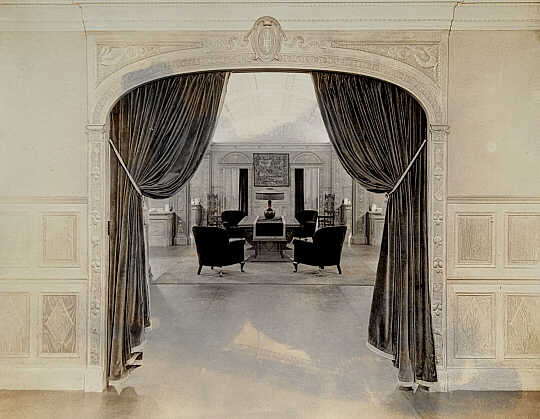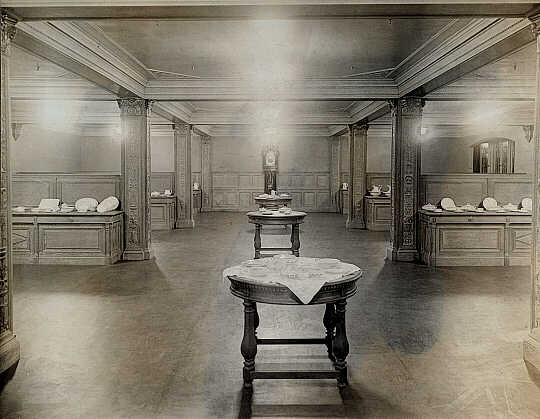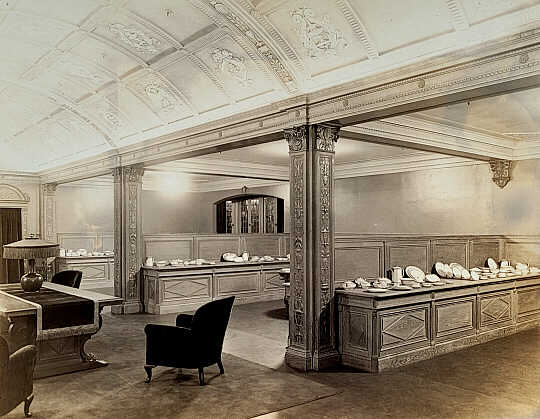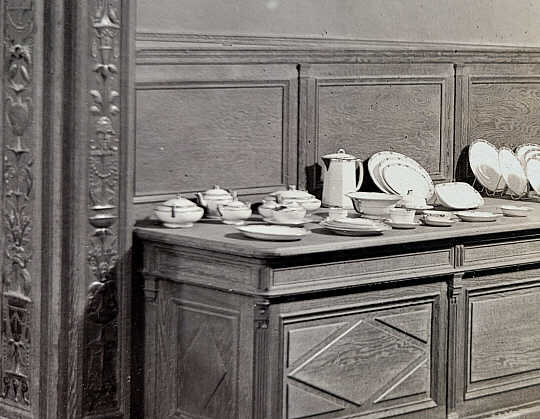|
Full article, "Fine Ceramic Manufacture, A Wonderful China Display Room" from Brick and Clay Record, June 13, 1922.
The splendor of the sample room of the Homer Laughlin China Co., Newell, W. Va., cannot be described in adjectives. There is nothing like it in the United States, therefore it cannot be compared with any display arrangement. Nothing is lacking in detail. The hand of the master is evident in the artistic arrangements. In harmony of colors, there is that soft blending which adds richness to all surroundings. Everything within the room has been worked out in harmony; there is nothing missing from an artistic point of view. And what is still better, the character of the merchandise displayed in this lovely room is of that high standard of quality which not only bespeaks the progressiveness of this firm, but mutely tells of the wonderful advancement made within the last years by the American potter.
It was almost a year ago that the Homer Laughlin China Co. laid plans to design a new sample room. A month later work was under way. Contracts were awarded [to]the James C. Hoe's Sons, New York, and the Homer Laughlin China Co.'s sample room now stands as a monument to their efforts.
The lighting arrangements are such that no ray of sunlight enters this new sample room. The soft glow of the sun seems to beam thru the large cathedral glass-panel windows on the south side of the room. This single lighting effect causes one to stand in wonderment.
From the main office of the company, the visitor is taken to the second floor, and there has been built what might be properly termed an ante room. From this room doors open to the stairway leading to the sample room. The steps are of polished oak. At either side of this stairway is a length of two-inch hemp rope each length being covered with mulberry colored silk velour, the seam of which is hid from view. Ascending these steps, one is compelled to glance upward and observe an arched ceiling, done in old ivory and with buried cornice lights sending forth their rays in a flood over the entire arch.
It is here that one begins to absorb the beauty of the thing. When one ascends the stairway, standing on quarter-inch battleship linoleum, there is that something which causes the visitor to pause, if only for a moment.
Then it is that magnificence of this new sample room begins to impress itself. True, one can observe parts of the entire space of 150 by 50 feet, but here and there more is to be observed. This space has been divided into three spaces, at either side of which are booths, and it is in these booths that the two hundred-odd dinnerware decorations are shown on the four dinner shapes of this firm. [Webmaster's note: the four dinnerware shapes at this time were Hudson, Empress, Republic, and Kwaker.]
A the top of the stairway, to the left, is the commercial department of the sample room. It is a most delightful corner. A beautiful, hand carved, flat top, antique birch finished desk has been provided, and placed here and there are chairs to match the desk. To the right of the commercial department is arranged the first sample booth, and in the center of this booth, just beneath the cathedral glass-panel window is a spacious window seat, on which has been placed a mulberry-colored silk velour cushion extending its entire length. There are two such seats arranged in the sample room.
Passing from this part of the sample room into the center room, over which the arched ceiling extends, one walks past a wall division in which as been built and arched entrance. Each doorway has been closed with mulberry silk velour draperies, finished in old ivory fringed edging. In the center of the arch at the "keystone" in and old ivory finished raised panel design in which has been worked the initial monogram of the firm. On the opposite side of the arch is another oval-shaped panel also showing the raised monogram of the company.
A very beautiful piece of Chinese woven tapestry, probably 36 inches square, has been suspended on the wall between the two arched entrances into the second display room, and beneath the arch.
On the center north wall of this room has been hung a bust portrait, in oil, of W. Edwin Wells of the Homer Laughlin Company, a gift of esteem from the company. It is a must delightful likeness.
Directly beneath the arched ceiling in this room has been placed a hand carved oak table, on which has been placed a large electric portable lamp, the color and design of which is in harmony with the other surroundings of the spacious room. At either side of this room, and in a third room beyond, display booths have been built. In the center of each booth has been placed one birch-finished table. These tables will be kept vacant at all times except when being used for the displaying of patterns during an interview.
| A closer look at the photos used in the article |

Entrance to center section |

Third section of showroom |

Center section of showroom |

Magnification of Kwaker on display |
All wood work is straight grain oak and finished in "Lenox Gray."
The booths are separated from the other by a four-foot nine-inch wall or partition, and at this height the visitor can have a clear observation of the entire sample room.
All ceiling panels and art designs on the columns are hand carved plastic relief work and are in Italian Renaissance. Walls and ceiling are finished in old ivory. All draperies are mulberry silk velour.
The heating and ventilation system is not exposed in any part of the sample room. Fresh air is obtained thru ducts back of the cathedral glass windows, and then forced about the room thru openings built in the base of the display counters. Foul air is forced out of the room thru other ducts. The heating system is also concealed under the counters. Warm air enters the room thru openings in the top of the display counters. This system of heating and ventilation insures circulation at all times of only the purest air.
A very interesting arrangement of hand painted covered jugs, open and covered "salads" [Kwaker shape] is a salient feature of the ceramic display, the work of Frank Nentwick, long identified with the decorating department of the Homer Laughlin China Co. He did not labor in vain. This special exhibit has been placed in a booth in the center section of the sample room, and the work of the artist is of such high character that it has been praised highly by all who have observed the assortment. [Webmaster's note: Ceramic artist Frank Valentine Nentwick was born in Germany in 1855, moved to the area in the 1880s. As the showroom article states, he worked at HLC in the 1920s. He died in 1933 and was buried in East Liverpool.]
In the arrangement of the skeleton sets on the display counters in the booths there has no crowding. In fact there is evenness of space between the different items which adds charm to the entire exhibit.
It is a matter of common knowledge that considerable pride inspired the work of everyone of the Homer Laughlin organization who had any part in the opening of this new sample room.
So today, there is in the American pottery industry, and located in West Virginia, a sample room to which the entire pottery industry of America can point with just pride, and feel absolutely secure in the thought that nothing similar has ever been designed, and it is exceedingly hard to conceive of anything superior. And what is still more assuring, is that the quality of the merchandise displayed is equal to any that has been worked out by the ceramic chemist. Therefore, this ample room is the "wonder room" of the American pottery industry.
|